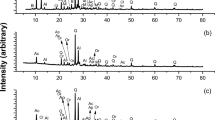Abstract
The effects of temperature and the presence of NaCl on bioleaching of chalcopyrite, enargite, and tennantite were studied. Rate of copper extraction from all minerals depended on temperature and was the highest at 45–50 °C. NaCl addition increased rate of copper extraction from chalcopyrite but led to the decrease in copper extraction from enargite and tennantite.
You have full access to this open access chapter, Download conference paper PDF
Similar content being viewed by others
Keywords
1 Introduction
Copper and zinc are mainly extracted from sulfide ores using pyrometallurgical techniques. Pyrometallurgical processing of arsenic containing ores is a problem due to the emission of toxic gases (Filippou et al. 2007). Biohydrometallurgy is widely used to process gold bearing concentrates, and may also be used to extract non-ferrous metals arsenic-containing concentrates (Neale et al. 2017). The goal of the present work was to study copper bioleaching from arsenic-containing minerals and chalcopyrite at different temperatures and in NaCl presence.
2 Methods and Approaches
Chalcopyrite (CuFeS2), enargite (Cu3AsS4), and tennantite (Cu12As4S13) as well as mixed culture of acidophilic microorganisms oxidizing ferrous iron and sulfur compounds were subjects of the study. The experiments were carried out in flasks with 100 ml of nutrient medium supplemented and 2 g of milled minerals (P100 75 µM) on a rotary shaker at temperatures from 40 °C to 60 °C for 30 days. In one variant of the experiment, nutrient medium was supplemented with100 mm NaCl.
3 Results and Discussion
The results of the experiments (rates of copper extraction) are shown in Table 1.
We showed that the rate of copper extraction from all minerals depended on temperature and was low at 40 °C. Extraction rate at 60 °C was also low as this temperature might inhibit microbial activity. Addition of NaCl increased rate of copper extraction from chalcopyrite that was a well known phenomenon. At the same time, NaCl addition led to the decrease in copper extraction rate.
4 Conclusions
The results obtained suggest that the efficiency of copper sulfide minerals depended on temperature, while NaCl addition did not allowed increasing the rate of copper bioleaching from arsenic-containing minerals in contrast to chalcopyrite. This fact should be taken into consideration when planning laboratory scale trials on bioleaching of copper sulfide concentrates.
References
Filippou D, St-Germain P, Grammatikopoulos T (2007) Recovery of metal values from copper – arsenic minerals and other related resources. Miner Process Extr Metall Rev 28(4):247–298
Neale J, Seppälä J, Laukka A, van Aswegen P, Barnett S, Gericke M (2017) The MONDO minerals nickel sulfide bioleach project: from test work to early plant operation. Solid State Phenom 262:28–32
Acknowledgements
The work was supported by the President Grant of the Russian Federation, grant No. MK-6639.2018.8.
Author information
Authors and Affiliations
Corresponding author
Editor information
Editors and Affiliations
Rights and permissions
Open Access This chapter is licensed under the terms of the Creative Commons Attribution 4.0 International License (http://creativecommons.org/licenses/by/4.0/), which permits use, sharing, adaptation, distribution and reproduction in any medium or format, as long as you give appropriate credit to the original author(s) and the source, provide a link to the Creative Commons license and indicate if changes were made.
The images or other third party material in this chapter are included in the chapter's Creative Commons license, unless indicated otherwise in a credit line to the material. If material is not included in the chapter's Creative Commons license and your intended use is not permitted by statutory regulation or exceeds the permitted use, you will need to obtain permission directly from the copyright holder.
Copyright information
© 2019 The Author(s)
About this paper
Cite this paper
Elkina, Y., Melnikova, E., Melamud, V., Bulaev, A. (2019). Biooxidation of Copper Sulfide Minerals. In: Glagolev, S. (eds) 14th International Congress for Applied Mineralogy (ICAM2019). ICAM 2019. Springer Proceedings in Earth and Environmental Sciences. Springer, Cham. https://doi.org/10.1007/978-3-030-22974-0_43
Download citation
DOI: https://doi.org/10.1007/978-3-030-22974-0_43
Published:
Publisher Name: Springer, Cham
Print ISBN: 978-3-030-22973-3
Online ISBN: 978-3-030-22974-0
eBook Packages: Earth and Environmental ScienceEarth and Environmental Science (R0)




